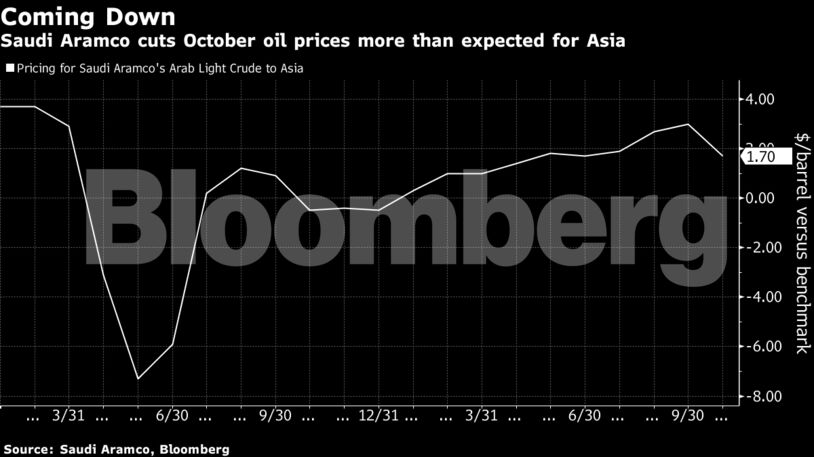But with Brent crude up 40% this year, OPEC+ sees enough demand — and a potential shortage by the end of the year — to allow it to raise production. That increase means more barrels competing for cautious buyers. Saudi Arabia, which sells all of its oil on long-term contracts to refiners, risks alienating customers if its sets monthly prices too high.
“Because of the high Saudi OSPs in previous months, traders have diverted to the spot market instead of using long term contracts,” said Giovanni Staunovo, a commodities analyst at UBS Group AG. Now Aramco wants buyers to take more Saudi crude, he said. “With domestic demand likely leveling off in autumn, they have more barrels to be exported, so that’s another reason to offer more attractive OSPs.”
Aramco is lowering pricing for Arab Light crude, its main oil grade, by $1.30 a barrel to a premium of $1.70 more than the regional benchmark, according to a statement. Aramco had been expected to reduce the oil selling price of the grade by around 60 cents a barrel, according to a survey of six traders and refiners in Asia last week.
Refiners in Asia, who are Aramco’s biggest customers were surprised by the scale of the cuts. The reductions signal the Saudis are trying to compete on price with other producers and to grab market share from rivals, according to the buyers.
Those refiners have suffered as swings in demand crimp profits from turning crude into fuels like gasoline and diesel. Saudi Arabia sends more than 60% of its crude exports to Asia, with China, South Korea, Japan and India the biggest buyers.
Aramco is keeping pricing to the U.S. and to Northwest Europe unchanged for October. For buyers in the Mediterranean region, Aramco is trimming pricing on all grades by 10 cents a barrel.
Aramco isn’t looking to increase sales in the U.S. as that country draws on strategic reserves, Staunovo said. Refinery capacity on the U.S. Gulf coast is shut in after Hurricane Ida ravaged the area.
OPEC+ this month decided to continue rolling back supply cuts implemented last year to support prices as the coronavirus slashed demand. Led by Saudi Arabia and Russia, the Organization of Petroleum Exporting Countries and partners are moving cautiously to get oil back onto the market amid continued flare-ups of the virus that are slowing economic recovery.
The group agreed in July to raise production by 400,000 barrels a day each month from August to unwind production cuts over the next year. Demand has improved from the depths of last year and the OPEC+ cuts have helped support markets with Brent trading at about $73 a barrel last week.
Share This:




 CDN NEWS |
CDN NEWS |  US NEWS
US NEWS 




























